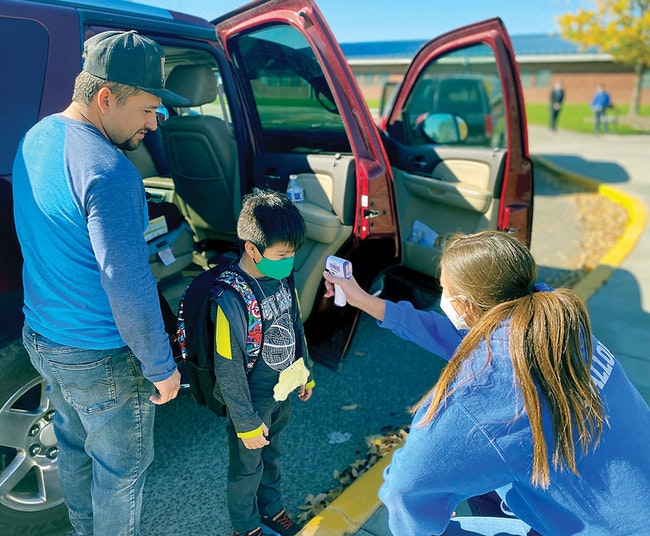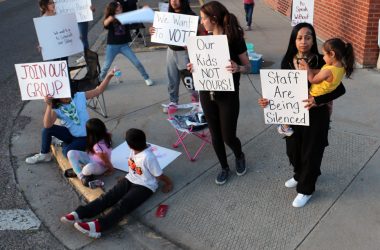
Victor Trujillo watches as son Juan Trujillo gets a temperature check recently outside the school from Lori Ballou of the Nyssa School staff. (The Enterprise/Les Zaitz)
Oregon school officials are considering changing rules to get more students back into classrooms.
Doing so without putting families and school workers at risk of contracting Covid is the challenge.
“Our highest priority is to open our schools to in-person instruction,” said Marc Siegel, communications director for the state Education Department. “We want each community to have the ability to do that as soon as we believe we can provide safety and stability for students, families and staff at the school.”
How rule changes would affect Malheur County’s 5,000 or so students isn’t clear. Smaller schools, such as Jordan Valley, have returned all students to classrooms. Other districts, including Nyssa and Vale, have conducted classes for small clusters of students and on a limited basis. Ontario has yet to return any students to school buildings.
The Governor’s Healthy Schools Reopening Council recently considered the need. The state is looking at experiences in other states with more liberal standards for in-person teaching.
Lisa Longoria, Ontario Middle School principal and member of the council, said educators, health officials and parents realize the value of getting students back into classrooms. The high rates of community spread of the coronavirus remain a roadblock.
“Everyone wants kids back in school but not everyone wants to do what it takes to get the numbers down,” Longoria said. “That’s really unfortunate.”
During the council discussion, there was a “lot of concern” about the desire to reopen schools clashing with the impact of people not wearing masks, social distancing and taking other precautions to slow the virus.
“If we can’t get the numbers down, we can’t get kids back in school,” she said.
Under current state rules, schools without Covid cases can return students to limited class time. In Malheur County, that means no more than 10 in a class and usually meeting for no more than two hours. Virtual distancing over the internet remains the primary way to teach.
Roberto Gamboa of Euvalcree, who also serves on the governor’s council, said the group discussed how to loosen the state’s rules “so in-person school can be a little more attainable.” He said that might be a slow expansion in school hours but even that could get students “more involved in schooling than they have been.”
In a statement after the council meeting, Gov. Kate Brown noted that children get more than lessons from school. They often rely on schools for meals and health care.
“Unfortunately, too many students do not have a stable place to call home,” Brown said. “These are the kids who need in-person instruction the most, the kids for whom a smile in a classroom or a helping hand in the lunchroom means everything.”
Brown’s statement said the council found a “major concern” with equal access to distance learning, noting the pandemic has had a more significant impact on minorities, including Latinos.
Gamboa said distance learning is particularly challenging in rural communities such as Malheur County.
“There was a lot of concern for a lot of children not getting a very good education,” Gamboa said.
One limit is access to internet services for students to join virtual classes.
Longoria said the Ontario School District has a special team to help arrange internet service and work with parents on virtual schooling questions.
“Nobody gets lost in the shuffle,” she said.
She said schools are providing students more ways to catch classwork besides joining a virtual class. She said family circumstances vary home to home, so some students are tending to siblings instead of going to class or sleeping because of their job schedule.
But such independent study isn’t always effective.
“Working on their own isn’t the best option all the time,” Longoria said.
Gamboa said closed schools means parents are faced with unexpected needs for someone to care for their children while they work.
“Parents are paying quite a bit in child care expenses,” he said. “It’s a larger need that’s not been fully met.”
He said state regulations and limits on child care slots could be changed to allow for more child care services, he said.
He also said another challenge is for students from Spanish-speaking homes. He said there are limits to how much school material is translated into Spanish.
“Those students have to go and receive special services in order to receive an education,” Gamboa said.
He said there aren’t enough Spanish-speaking teachers.
“There’s no way they can meet the great need of all the students needing assistance,” he said.
Charles Boyle, spokesman for the governor, said the Education Department and Oregon Health Authority are reviewing how other states reopened schools and evaluating pandemic data.
“They are trying to balance the risk of transmission from opening schools with the negative health impacts of education delivery only through comprehensive distance learning,” Boyle said in a statement.
GET YOUR LOCAL NEWS FROM REAL PROFESSIONALS: Reader support allows the Enterprise to provide in-depth, accurate reporting that otherwise would not get done. Keeping the community well informed is essential. SUBSCRIBE – $5 a month, automatically. DONATE – to provide additional support.




